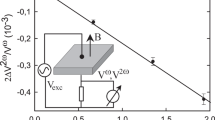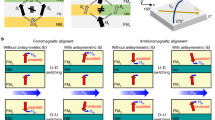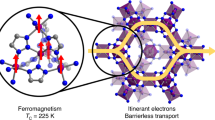Abstract
As materials science is moving towards the synthesis, the study and the processing of new materials exhibiting well-defined and complex functions, the synthesis of new multifunctional materials is one of the important challenges. One of these complex physical properties is magneto-chiral dichroism which arises, at second order, from the coexistence of spatial asymmetry and magnetization in a material. Herein we report the first measurement of strong magneto-chiral dichroism in an enantiopure chiral ferromagnet. The ab initio synthesis of the enantiopure chiral ferromagnet is based on an enantioselective self-assembly, where a resolved chiral quaternary ammonium cation imposes the absolute configurations of the metal centres within chromium–manganese two-dimensional oxalate layers. The ferromagnetic interaction between Cr(III) and Mn(II) ions leads to a Curie temperature of 7 K. The magneto-chiral dichroic effect is enhanced by a factor of 17 when entering into the ferromagnetic phase.
This is a preview of subscription content, access via your institution
Access options
Subscribe to this journal
Receive 12 print issues and online access
$259.00 per year
only $21.58 per issue
Buy this article
- Purchase on Springer Link
- Instant access to full article PDF
Prices may be subject to local taxes which are calculated during checkout






Similar content being viewed by others
References
Kahn, O. Molecular Magnetism (VCH, New York, 1993).
Miller, J. S. & Drillon, M (eds) Magnetism: Molecules to Materials Vol. 1–5 (Wiley–VCH, Weinheim, 2001–2005).
Manriquez, J. M., Yee, G. T., McLean, R. S., Epstein, A. J. & Miller, J. S. A room-temperature molecular-organic-based magnet. Science 252, 1415–1417 (1991).
Ferlay, S., Mallah, T., Ouahès, R., Veillet, P. & Verdaguer, M. A room-temperature organometallic magnet based on Prussian blue. Nature 378, 701–703 (1995).
Holmes, S. M. & Girolami, G. S. Sol–gel synthesis of KVII[CrIII(CN)6]·2H2O: A crystalline molecule-based magnet with a magnetic ordering temperature above 100 ∘C. J. Am. Chem. Soc. 121, 5593–5594 (1999).
Gatteschi, D., Caneschi, A., Pardi, L. & Sessoli, R. Large clusters of metal-ions—the transition from molecular to bulk magnets. Science 265, 1054–1058 (1994).
Sessoli, R., Gatteschi, D., Caneschi, A. & Novak, M. A. Magnetic bistability in a metal-ion cluster. Nature 365, 141–143 (1993).
Thomas, L. et al. Macroscopic quantum tunnelling of magnetization in a single crystal of nanomagnets. Nature 383, 145–147 (1996).
Gatteschi, D., Sessoli, R. & Villain, J. Molecular Nanomagnets (Oxford Univ. Press, New York, 2006).
Gütlich, P. & Goodwin, H. A. (eds) Spin Crossover in Transition Metal Compounds Vol. 1–3 (Springer, Wien, 2004).
Kurmoo, M. et al. Superconducting and semiconducting magnetic charge-transfer salts— (BEDT-TTF)4AFe(C2O4)3·C6H5CN (A=H2O, K, NH4). J. Am. Chem. Soc. 117, 12209–12217 (1995).
Coronado, E., Galan-Mascaros, J. R., Gomez-Garcia, C. J. & Laukhin, V. Coexistence of ferromagnetism and metallic conductivity in a molecule-based layered compound. Nature 408, 447–449 (2000).
Ohkoshi, S. et al. Coexistence of ferroelectricity and ferromagnetism in a rubidium manganese hexacyanoferrate. Angew. Chem. Int. Ed. 46, 3238–3241 (2007).
Andres, R. et al. Rational design of three dimensional (3D) optically active molecule-based magnets: Synthesis, structure, optical and magnetic properties of {[Ru(bpy)3]2+,ClO4−,[MnIICrIII(ox)3]−}n and {[Ru(bpy)2(ppy)]+,[MIICrIII(ox)3]−}n with MII=Mn, Ni; bpy=bipyridine, ppy=phenylpyridine, ox=C2O42−. X-ray Structure of {[ΔRu(bpy)3]2+,ClO4−,[ΔMnIIΔCrIII(ox)3]−}n and {[ΛRu(bpy)2(ppy)]+,[ΛMnIIΛCrIII(ox)3]−}n . Inorg. Chem. 40, 4633–4640 (2001).
Spaldin, N. A. & Fiebig, M. The renaissance of magnetoelectric multiferroics. Science 309, 391–392 (2005).
Eerenstein, W., Mathur, N. D. & Scott, J. F. Multiferroic and magnetoelectric materials. Nature 442, 759–765 (2006).
Baranova, N. B. & Zeldovich, B. Y. Theory of a new linear magneto-refractive effect in liquids. Mol. Phys. 38, 1085–1098 (1979).
Barron, L. D. & Vrbancich, J. Magneto-chiral birefringence and dichroism. Mol. Phys. 51, 715–730 (1984).
Rikken, G. L. J. A. & Raupach, E. Observation of magneto-chiral dichroism. Nature 390, 493–494 (1997).
Rikken, G. L. J. A. & Raupach, E. Pure and cascaded magnetochiral anisotropy in optical absorption. Phys. Rev. E 58, 5081–5084 (1998).
Kleindienst, P. & Wagniere, G. H. Interferometric detection of magnetochiral birefringence. Chem. Phys. Lett. 288, 89–97 (1998).
Vallet, M. et al. Observation of magnetochiral birefringence. Phys. Rev. Lett. 87, 183003 (2001).
Sautenkov, V. A. et al. Electromagnetically induced magnetochiral anisotropy in a resonant medium. Phys. Rev. Lett. 94, 233601 (2005).
Rikken, G. & Raupach, E. Enantioselective magnetochiral photochemistry. Nature 405, 932–935 (2000).
Raupach, E., Rikken, G., Train, C. & Malezieux, B. Modelling of magneto-chiral enantioselective photochemistry. Chem. Phys. 261, 373–380 (2000).
Rikken, G. L. J. A., Fölling, J. & Wyder, P. Electrical magnetochiral anisotropy. Phys. Rev. Lett. 87, 236602 (2001).
Krstic, V., Roth, S., Burghard, M., Kern, K. & Rikken, G. Magneto-chiral anisotropy in charge transport through single-walled carbon nanotubes. J. Chem. Phys. 117, 11315–11319 (2002).
Kimura, T., Sekio, Y., Nakamura, H., Siegrist, T. & Ramirez, A. P. Cupric oxide as an induced-multiferroic with high-Tc . Nature Mater. 7, 291–294 (2008).
Coronado, E. et al. Design of chiral magnets: cyanide-bridged bimetallic assemblies based on cyclohexane-1,2-diamine. Polyhedron 22, 2435–2440 (2003).
Inoue, K., Kikuchi, K., Ohba, M. & Okawa, H. Structure and magnetic properties of a chiral two-dimensional ferrimagnet with Tc of 38 K. Angew. Chem. Int. Ed. 42, 4810–4813 (2003).
Gruselle, M., Train, C., Boubekeur, K., Gredin, P. & Ovanesyan, N. Enantioselective self-assembly of chiral bimetallic oxalate-based networks. Coord. Chem. Rev. 250, 2491–2500 (2006).
Pilkington, M. & Decurtins, S. in Magnetism: Molecules to Materials II (eds Miller, J. S. & Drillon, M.) 339–356 (Wiley–VCH, Weinheim, 2001).
Clement, R., Decurtins, S., Gruselle, M. & Train, C. Polyfunctional 2-(2D) and 3-(3D) dimensional oxalate bridged bimetallic magnets. Monatsh. Chem. 134, 117–135 (2003).
Andres, R., Gruselle, M., Malezieux, B., Verdaguer, M. & Vaissermann, J. Enantioselective synthesis of optically active polymeric homo- and bimetallic oxalate-bridged networks [M2(ox)3]n . Inorg. Chem. 38, 4637–4646 (1999).
Provent, C. & Williams, A. F. in Transition Metals in Supramolecular Chemistry (ed. Sauvage, J.-P.) 135–191 (Wiley, Chichester, 1999).
Alvarez, S., Alemany, P. & Avnir, D. Continuous chirality measures in transition metal chemistry. Chem. Soc. Rev. 34, 313–326 (2005).
Carling, S. G. et al. Crystal structure and magnetic properties of the layer ferrimagnet N(n-C6H11)4MnIIFeIII(C2O4)3 . J. Chem. Soc. Dalton Trans. 1839–1843 (1996).
Bénard, S. et al. Structure and NLO properties of layered bimetallic oxalato-bridged ferromagnetic networks containing stilbazolium-shaped chromophores. J. Am. Chem. Soc. 122, 9444–9454 (2000).
Gruselle, M. et al. Enantioselective self-assembly of bimetallic [MnII(Δ)-CrIII(C2O4)3]− and [MnII(Λ)-CrIII(C2O4)3]− layered anionic networks templated by the optically active (Rp)- and (Sp)-[1-CH2N(n-C3H7)3-2-CH3-C5H3Fe-C5H5]+ cations. Chem. Eur. J. 10, 4763–4769 (2004).
Gheorghe, R. et al. Enantiomerically pure quaternary ammonium salts with a chiral alkyl chain N(CH3)(n-C3H7)2(s-C4H9)I: Synthesis and physical studies. Chirality (2008, in the press).
Gillard, R. D., Shepherd, D. J. & Tarr, D. A. Optically-active coordination-compounds.38. Circular-dichroism of labile trioxalatometallate(III) complexes. J. Chem. Soc. Dalton Trans. 594–599 (1976).
Flack, H. D. & Bernardinelli, G. Reporting and evaluating absolute-structure and absolute-configuration determinations. J. Appl. Cryst. 33, 1143–1148 (2000).
Atovmyan, L. O. et al. Structural, magnetic and Moessbauer studies of the molecular ferromagnet compounds NBu4[MCr(C2O4)3] (Bu=(CH2)3CH3, M=Mn,Fe). Synth. Metals 71, 1809–1810 (1995).
Tamaki, H. et al. Design of metal-complex magnets. Syntheses and magnetic properties of mixed-metal assemblies {NBu4[MCr(C2O4)3]}x(NBu4+=tetra(n-butyl)ammonium ion; ox2−=oxalate ion; M=Mn2+, Fe2+, Co2+, Ni2+, Cu2+, Zn2+). J. Am. Chem. Soc. 114, 6974–6979 (1992).
Jung, J. H. et al. Optical magnetoelectric effect in the polar GaFeO3 ferrimagnet. Phys. Rev. Lett. 93, 037403 (2004).
Sawada, K. & Nagaosa, N. Optical magnetoelectric effect in multiferroic materials: Evidence for a Lorentz force acting on a ray of light. Phys. Rev. Lett. 95, 237402 (2005).
Bailar, J. C. & Jones, E. M. Synthesis of tris(oxalato)metalate(III) potassium and salts. Inorg. Synth. 1, 37–40 (1939).
Duisenberg, A. J. M., Kroon-Batenburg, L. M. J. & Schreurs, A. M. M. An intensity evaluation method: EVAL-14. J. Appl. Crystallogr. 36, 220–229 (2003).
Blessing, R. H. An empirical correction for absorption anisotropy. Acta Crystallogr. A 51, 33–38 (1995).
Sheldrick, G. M. A short history of SHELX. Acta Crystallogr. A 64, 112–122 (2008).
Farrugia, L. J. WinGX suite for small-molecule single-crystal crystallography. J. Appl. Crystallogr. 32, 837–838 (1999).
Acknowledgements
This work was supported by the UPMC, CNRS and Russian Academy of Sciences. The authors acknowledge financial support from Deutsche Forschungsgemeinschaft (RI 1027 for instrumentation and SPP 1137 for the grant of R.G.), CNRS/RAS Joint Research Program (project No. 16332) and the RFBR grant No. 05-03-33026. Discussions with K. Boubekeur about the crystallographic determination were particularly useful.
Author information
Authors and Affiliations
Contributions
C.T. proposed the appropriate chiral ammonium, undertook the magnetic measurements, took part in the MChD measurements and coordinated the whole work. R.G. carried out the synthesis and single-crystal growth. V.K. carried out the MChD measurements. L.M.C. recorded the crystallographic data and solved the structure. N.S.O. took part in the analysis of the magnetic and structural data. G.L.J.A.R. conceived and built the cryostat and the MChD measurement device and supervised the MChD measurements. M.G. was in charge of the synthetic part of the project from the beginning and supervised daily the synthetic work of R.G. M.V. launched the chiral magnets project and took part in the MChD measurements.
Corresponding authors
Rights and permissions
About this article
Cite this article
Train, C., Gheorghe, R., Krstic, V. et al. Strong magneto-chiral dichroism in enantiopure chiral ferromagnets. Nature Mater 7, 729–734 (2008). https://doi.org/10.1038/nmat2256
Received:
Accepted:
Published:
Issue Date:
DOI: https://doi.org/10.1038/nmat2256
This article is cited by
-
Optical Tellegen metamaterial with spontaneous magnetization
Nature Communications (2024)
-
Nonreciprocal directional dichroism at telecom wavelengths
npj Quantum Materials (2022)
-
Thermal conductivity of micro/nano-porous polymers: Prediction models and applications
Frontiers of Physics (2022)
-
Ambi-chiral anomalous Hall effect in magnetically doped topological insulators
Science China Physics, Mechanics & Astronomy (2022)
-
Crystal-chirality-dependent control of magnetic domains in a time-reversal-broken antiferromagnet
npj Quantum Materials (2021)



